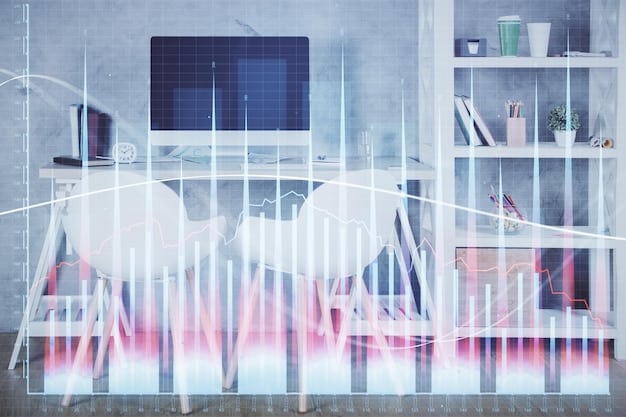The Impact of Inflation on US Tech Spending: Next 6 Months

The impact of inflation on US tech spending over the next six months is expected to result in cautious investment, prioritization of essential upgrades, and a shift towards cloud-based solutions, as companies seek to optimize their budgets and maintain competitiveness.
The tech sector in the US, known for its rapid innovation and high growth, is now facing a significant challenge: inflation. The rising costs of goods and services are forcing businesses to re-evaluate their budgets and investment strategies. Understanding the impact of inflation on US tech spending: what to expect in the next 6 months is crucial for navigating this economic landscape.
Understanding Inflation’s Grip on the US Economy
Inflation has become a central concern for businesses across all sectors, and the tech industry is no exception. It’s essential to understand the underlying factors driving inflation in the US and how these factors specifically affect tech companies.
Several factors contribute to the current inflationary environment. Supply chain disruptions, increased consumer demand post-pandemic, and rising labor costs have all played a role. These pressures translate into higher prices for raw materials, components, and skilled workers, all vital to the tech industry.
How Inflation Directly Impacts Tech Companies
Inflation affects tech firms in various ways, from increasing operational expenses to potentially dampening consumer demand for tech products and services. Companies need to carefully manage these impacts to maintain profitability and growth.
- Higher component costs: The price of semiconductors, displays, and other essential components has risen, increasing the cost of manufacturing hardware.
- Increased labor costs: Competition for skilled tech workers is fierce, driving up salaries and wages.
- Reduced consumer spending: As inflation erodes purchasing power, consumers may cut back on discretionary spending, including new gadgets and subscriptions.
To mitigate these challenges, tech companies are exploring various strategies, including optimizing supply chains, increasing prices where possible, and focusing on cost-efficient solutions.

Companies that can adapt quickly and efficiently are more likely to weather the inflationary storm and emerge stronger.
The Short-Term Outlook: Projecting Tech Spending Trends
Predicting the precise trajectory of tech spending in the next six months requires a careful analysis of current economic indicators and industry trends. Several forecasts suggest a slowdown in certain areas, while others show continued growth.
Analysts generally agree that overall tech spending will likely moderate as companies become more cautious about investments. However, specific sectors, such as cloud computing and cybersecurity, are expected to remain robust due to their essential nature.
Areas Likely to See Spending Cuts
Certain segments of the tech industry are more vulnerable to spending cuts during inflationary periods. Understanding these areas can help businesses make informed decisions about their budgets.
- Hardware: Purchases of non-essential hardware, such as desktops and laptops, may be delayed or reduced.
- Research and development: Some companies may scale back long-term R&D projects to prioritize short-term profitability.
- Marketing: Marketing budgets, particularly for less effective campaigns, could face scrutiny and potential cuts.
Companies will likely prioritize essential upgrades and maintenance over new, discretionary purchases. This shift reflects a focus on maximizing the lifespan of existing assets.
Focus on cost-effective strategies and essential upgrades is paramount for navigating the short-term economic challenges.
Cloud Computing: A Safe Haven in Uncertain Times
Cloud computing has emerged as a critical component of IT infrastructure for businesses of all sizes. Its scalability, flexibility, and cost-effectiveness make it particularly attractive during periods of economic uncertainty.
Inflation has actually strengthened the value proposition of cloud computing. By migrating to the cloud, companies can reduce capital expenditures on hardware, lower energy costs, and streamline IT operations, all of which contribute to significant savings.
Benefits of Cloud Adoption During Inflation
Adopting cloud solutions can offer several specific advantages during inflationary times, helping businesses optimize their spending and improve efficiency.
- Reduced capital expenditure: Eliminates the need to invest in expensive on-premises hardware.
- Scalability: Easily adjust resources based on demand, avoiding overspending on unused capacity.
- Improved efficiency: Streamlines IT operations and reduces the need for in-house IT staff.

As inflation persists, the shift towards cloud computing is expected to accelerate, making it a key area of investment for businesses looking to stay competitive.
The cost-saving and efficiency gains offered by cloud solutions make them a strategic investment for businesses facing inflationary pressures.
Cybersecurity: An Unavoidable Expense
In an increasingly interconnected world, cybersecurity is no longer an optional expense but a fundamental necessity. The cost of data breaches and cyberattacks continues to rise, making robust cybersecurity measures essential for protecting sensitive information and maintaining business operations.
Despite inflationary pressures, companies are unlikely to cut back on cybersecurity spending. The potential financial and reputational damage from a successful cyberattack far outweighs the cost of investing in adequate protection.
Key Cybersecurity Investments
To effectively mitigate cyber risks, businesses need to prioritize specific areas of cybersecurity investment.
- Advanced threat detection: Implementing systems that can identify and respond to sophisticated cyberattacks.
- Employee training: Educating employees about phishing scams, malware, and other cyber threats.
- Data encryption: Protecting sensitive data both in transit and at rest.
As cyber threats become more sophisticated, companies will need to continually invest in innovative cybersecurity solutions to stay ahead of the curve.
Prioritizing cybersecurity investments is a strategic imperative for businesses aiming to protect their assets and maintain customer trust.
Strategies for Tech Companies to Weather the Storm
Navigating the inflationary landscape requires a strategic and adaptable approach. Tech companies need to implement a combination of cost-saving measures, revenue optimization strategies, and innovative solutions to maintain profitability and growth.
One of the most important steps is to carefully evaluate current spending and identify areas where costs can be reduced without compromising essential operations. This may involve renegotiating contracts with suppliers, streamlining processes, or consolidating resources.
Effective Cost-Saving Measures
Several specific cost-saving measures can help tech companies navigate inflationary pressures.
- Energy efficiency: Reducing energy consumption through efficient hardware and optimized data centers.
- Remote work: Lowering real estate costs by encouraging remote work arrangements.
- Automation: Automating repetitive tasks to reduce labor costs.
In addition to cost-saving measures, tech companies should explore opportunities to increase revenue. This may involve developing new products and services, expanding into new markets, or increasing prices where justified by value.
Adopting a proactive and adaptable approach will be crucial for tech companies to navigate the inflationary landscape successfully.
Long-Term Implications: Adapting to a New Economic Reality
The current inflationary environment may not be a temporary phenomenon. Tech companies need to consider the long-term implications and adapt their strategies accordingly. This may involve rethinking business models, diversifying supply chains, and investing in innovation.
One of the key challenges will be managing talent in an increasingly competitive labor market. As inflation erodes purchasing power, employees will demand higher wages. Tech companies need to balance the need to attract and retain talent with the need to control costs.
Preparing for the Future
To thrive in the long term, companies need to focus on adaptability and innovation.
- Diversified supply chains: Reducing reliance on single suppliers to mitigate disruptions.
- Flexible business models: Adapting quickly to changing market conditions.
- Investment in innovation: Developing new technologies and solutions to stay ahead of the competition.
By embracing these strategies, tech companies can position themselves for long-term success in a dynamic and challenging economic landscape.
Investing in innovation and adapting to new economic realities are crucial for companies looking to thrive in the long term.
| Key Point | Brief Description |
|---|---|
| 💡 Cloud Adoption | Shifting to cloud solutions to reduce capital and operational costs. |
| 🛡️ Cybersecurity | Maintaining cybersecurity investments to protect against rising cyber threats. |
| 💰 Cost Efficiency | Implementing cost-saving measures such as remote work and automation. |
| 🌐 Diversification | Diversifying supply chains and business models for long-term resilience. |
FAQ
▼
Inflation leads to higher component costs, impacting hardware spending. Companies may delay non-essential purchases and focus on upgrades.
▼
Cloud computing reduces capital expenditure, lowers energy costs, and streamlines IT operations, offering significant savings during inflation.
▼
Companies are unlikely to cut cybersecurity spending as the cost of breaches outweighs the investment in protection, making it a priority.
▼
Energy efficiency, remote work arrangements, and automating repetitive tasks are effective cost-saving measures for tech companies.
▼
Diversifying supply chains, adopting flexible business models, and investing in innovation are crucial strategies for long-term success.
Conclusion
In conclusion, the impact of inflation on US tech spending: what to expect in the next 6 months will require tech companies to be adaptable, strategic, and innovative. By embracing cost-saving measures, prioritizing essential investments like cloud computing and cybersecurity, and preparing for long-term economic shifts, businesses can navigate these challenges and emerge stronger.